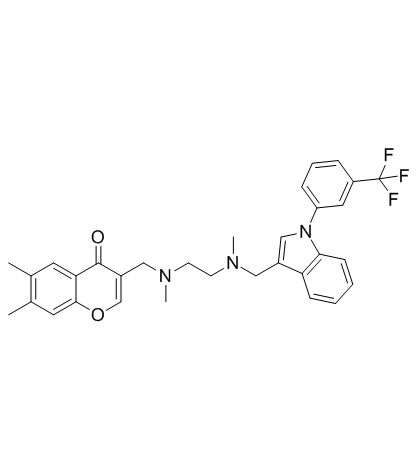SPD304 |
| Catalog No.GC33133 |
Le SPD304 est un inhibiteur sélectif du TNF-α, qui favorise la dissociation des trimères du TNF et bloque donc l'interaction du TNF et de son récepteur. SPD304 a une IC50 de 22 μM pour inhiber la liaison in vitro du récepteur 1 du TNF (TNFR1) au TNF-α.
Products are for research use only. Not for human use. We do not sell to patients.

Cas No.: 869998-49-2
Sample solution is provided at 25 µL, 10mM.
SPD304 is a selective inhibitor of tumor necrosis factor α (TNFα) and promotes dissociation of TNF trimers and therefore blocks the interaction of TNF and its receptor, with an IC50 of 22 µM for inhibiting in vitro TNF receptor 1 (TNFR1) binding to TNF-α[1][2]. SPD304 cannot be used in vivo due to its high toxicity[3].
SPD304 (2 μM) significantly rescues the survivability of aHSCs, reduces the production of lipid hydroxides, and increased intracellular GSH. The co-treatment of GA (75 μM) and SPD304 (2 μM), down-regulate TRADD almost 2-fold (w/o inhibitor vs. w/ inhibitor) and p-RIP3 1.4-fold compared to GA alone, and promotes caspase 8 activation[4].
[1]. Molly M. He, et al. Small-Molecule Inhibition of TNF-α. Science 11 Nov 2005. [2]. Alexiou P, et al. Rationally designed less toxic SPD-304 analogs and preliminary evaluation of their TNF inhibitory effects. Arch Pharm (Weinheim). 2014 Nov;347(11):798-805. [3]. Mouhsine H, et al. Identification of an in vivo orally active dual-binding protein-protein interaction inhibitor targeting TNFα through combined in silico/in vitro/in vivo screening. Sci Rep. 2017 Jun 13;7(1):3424. [4]. Gallic acid induces necroptosis via TNF-α signaling pathway in activated hepatic stellate cells. Chang YJ, et al. PLoS One. 2015 Mar 27;10(3):e0120713.
Average Rating: 5 (Based on Reviews and 28 reference(s) in Google Scholar.)
GLPBIO products are for RESEARCH USE ONLY. Please make sure your review or question is research based.
Required fields are marked with *




















